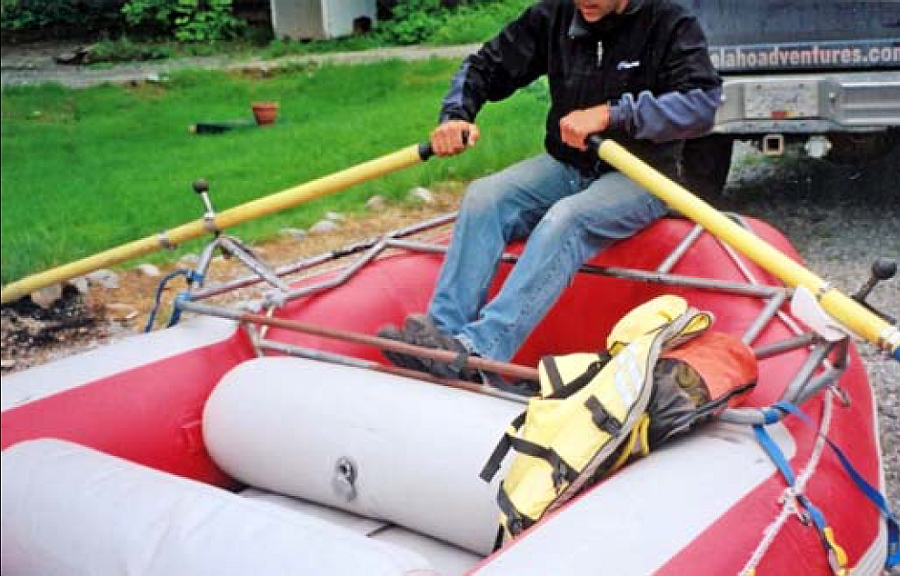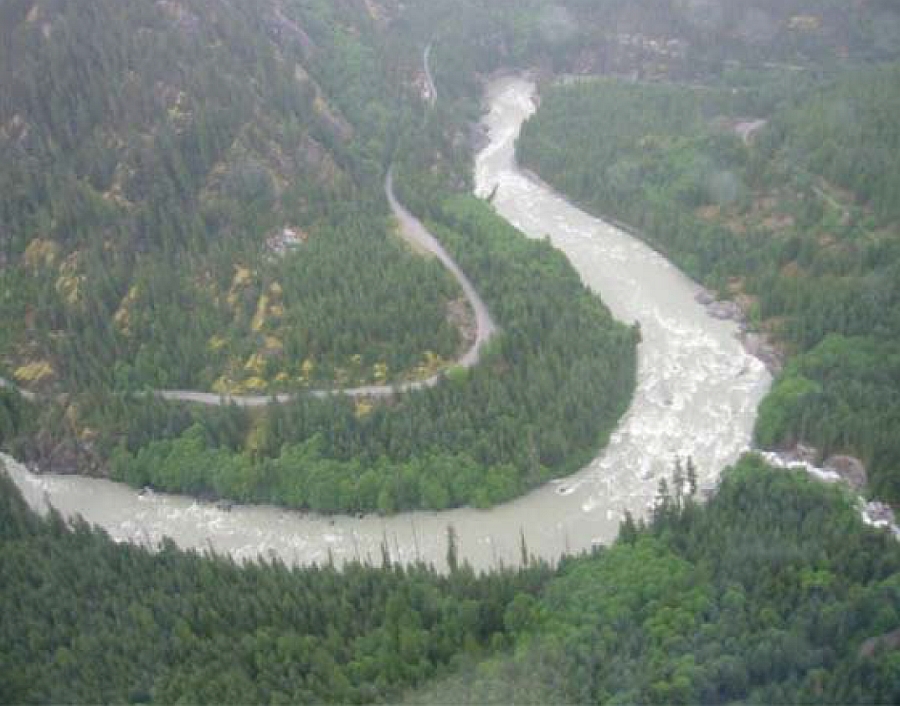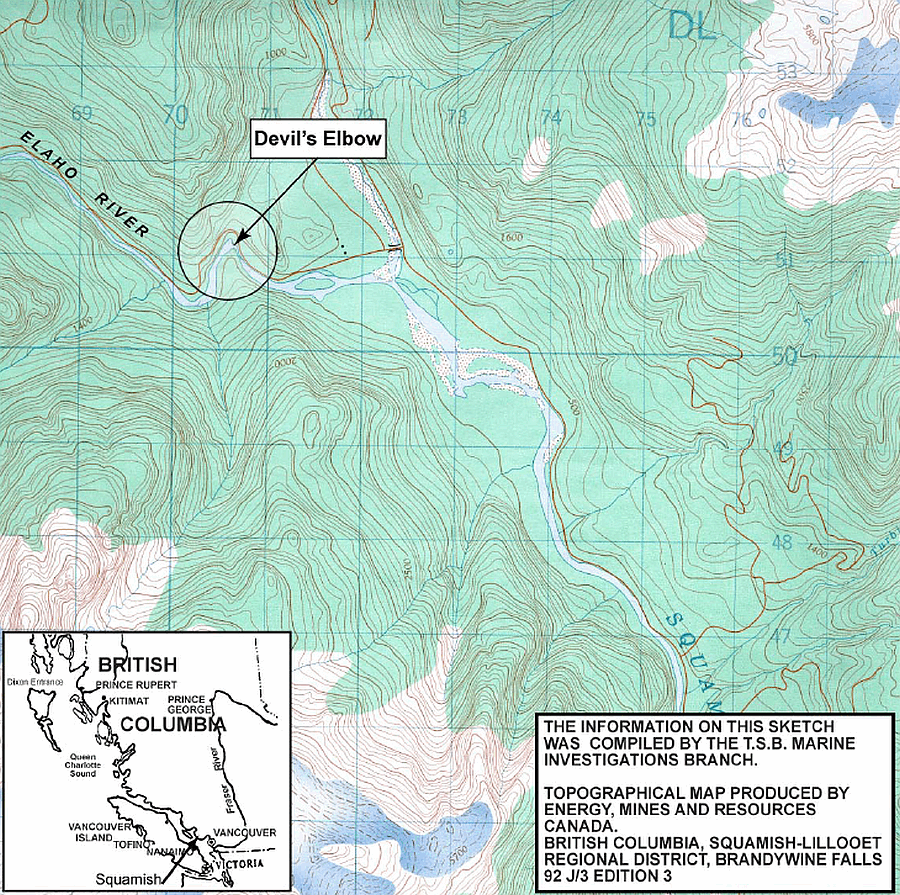Capsizing
Inflatable river raft
Elaho River
Squamish, British Columbia
The Transportation Safety Board of Canada (TSB) investigated this occurrence for the purpose of advancing transportation safety. It is not the function of the Board to assign fault or determine civil or criminal liability. This report is not created for use in the context of legal, disciplinary or other proceedings. See Ownership and use of content. Masculine pronouns and position titles may be used to signify all genders to comply with the Canadian Transportation Accident Investigation and Safety Board Act (S.C. 1989, c. 3).
Summary
On 14 May 2005, an inflatable raft carrying nine people capsized while descending the Elaho River, north of Squamish, British Columbia. Three occupants managed to climb onto a large rock in mid-river from where they were later rescued by helicopter. The remaining six people fell into the water and were swept downstream. All were rescued except for one person who drowned.
Factual information
Particulars of the raft
| Type | Self-bailing inflatable river raft |
|---|---|
| Length | 4.7 m |
| Width | 2.1 m |
| Tube material | Polyvinyl chloride (PVC) synthetic fibre |
| Builder of manufacturer | Star Inflatables, South Carolina, United States |
| Propulsion | Paddles/oars |
| Crew | 1 trip leader/guide |
| Passengers | 8 |
| Owner | Elaho River Adventures, Squamish, British Columbia |
Description of the raft
The raft consists of a single continuous PVC tube that forms the sides of the raft as well as the raked bow and stern. The tube is divided into four chambers that, when filled with air, provide buoyancy. Transverse rigidity is achieved by four rows of buoyancy tubes lashed at regular intervals to the interior sides of the raft. A nylon grab line is secured to the exterior periphery of the raft.
The raft floor has its own air chamber with ports to dispense water from the craft known as "self-bailers." A rectangular steel steering frame is fitted over the top of the buoyancy tube at the stern. A guide sits at the stern looking forward and steers the raft by means of left- and right-side oars that rest in metal brackets held in place by clips attached to vertical "thole pins."Footnote 1
Passengers sit on top of the left and right sides of the main buoyancy tube, with their legs inside the raft. They wedge their feet into the space between the floor, cross tubes, and the main tube.
Elaho River
The Elaho River is a medium-volume, glacier-fed river in the Coast Mountains of British Columbia approximately 60 km northwest of Squamish, British Columbia. River turbulence can change daily depending on rainfallFootnote 2 and the rate of glacial runoff, which is dependent upon sunlight and temperature. As the river level changes, so do the relative positions of submerged obstructions such as boulders, stumps, and logs.
Preparation for May 14 rafting trip
Representatives of a local troop of Girl Guides arranged for six girls and two adults to raft down the river on 14 May 2005. One girl was 17 years old, and five were younger than 13. The eight passengers, along with a separate group of six adults not associated with Girl Guides, gathered at the premises of an established rafting outfitter north of Squamish. Each of the two groups was assigned their own raft and guide.
Everyone was fitted with protective clothing including neoprene wetsuits, booties, water-resistant spray jackets, and personal flotation devices (PFDs). The PFDs were suitable for persons weighing more than 41 kg and specifically designed for such excursions. After the two groups were fitted with equipment, they and their three guides - 17 people in all - boarded a company bus and were driven to an embarkation point on the Elaho River.
Following company practice, one guide was designated "trip leader." He was recognized as the person in charge of the safe conduct of all passengers and all craft participating in that trip. Before getting underway, the trip leader delivered a safety briefing to the passengers, which included the following information:
- use of safety lines attached to each raft;
- importance of following all commands given by the rafting guide;
- identification of paddle commands;
- procedures for entering, leaving, and staying positioned in the raft; and
- procedures for dealing with hazardous situations, including encountering partially submerged logs after falling overboard.
Description of the descent
At around noon, the craft began their descent of the Elaho River. A "safety kayak" was at the head of the formation. Next was the raft with six adult passengers; it was followed by the raft with the six Girl Guides, two adult passengers, and the trip leader. The three guides kept the craft approximately two boat lengths apart so that they could easily communicate by voice, whistle, or hand signals. The water was calm at the beginning of the voyage, and passengers in both rafts were able to practice paddling according the guides' commands. Meanwhile, the bus that had transported the passengers to the site was following along via an adjacent logging road, with the driver visually monitoring the rafts' progress.
After about 1 km, the convoy reached a river section known as "Devil's elbow" (see Appendix A). There, the three craft encountered numerous waves, rocks, eddies and rapids. Both the safety kayak and the first raft traversed the area without mishap, but the right oar of the second raft struck a rock on the riverbed, jarring the oar loose from its lock so that it was briefly unusable for steering.
As the raft diverted from the preferred course, the trip leader gave corrective paddle commands. Passengers quickly complied, but they were unable to prevent the raft from turning broadside to the current and striking a large, exposed rock in mid-river. The force of the rushing water lifted the raft's downstream side, throwing six passengers into the river. The trip leader and the other two passengers were able to crawl to the top of the rock. The raft then floated downriver, where it was later retrieved.
After the capsizing
The bus driver observed the capsizing and made an emergency call to the rafting company office using a two-way radio. Office staff called 911, and from there a phone call was placed to the Provincial Emergency Program, which dispatched a helicopter rescue team and an ambulance. Meanwhile, of the six people thrown into the water, three were rescued by those in the other raft, and two were rescued by the guide in the safety kayak. After taking them ashore, he then paddled the kayak upstream, searching for the final passenger. After about five minutes, he found her underwater, the force of the current pressing her body against a partially submerged log. Efforts to resuscitate her failed.
By this time, a rescue helicopter had arrived. It evacuated the three people from the mid-river rock and transported them to a hospital in Squamish, where they were examined and released. The other passengers arrived at the hospital by ambulance and were also released. None of them was injured.
Rafting company personnel
Before 14 May 2005, the three guides had made a combined total of more than 800 commercial rafting descents on this river section without serious incident. Each had received water-rescue training and been certified as a "trip leader" under terms of the British Columbia Commercial River Rafting Safety Act and Commercial River Rafting Safety Regulations. The Act was repealed in 2003 after which time training has been provided by a professional organization called the British Columbia River Outfitters Association (BCROA).Footnote 3
British Columbia River Outfitters Association
The guides were employees of a company that belonged to the BCROA, which has the following mandate:
- To represent the interests of commercial river outfitters in discussions with government and other agencies;
- To promote a high standard of safety and operations in the river outfitter industry; and
- To initiate, organize, and manage programs to improve the operations for outfitters.
Current safety guidelines
According to Transport Canada (TC), approximately 230 000 people go river rafting each year in Canada, and there are over 230 rafting companies operating in the country. In 1981, recognizing the hazards of river rafting, TC attempted to minimize the risk of injuries by introducing federal standards.Footnote 4 As these were voluntary, however, some provincial governments and professional river-rafting organizations developed their own guidelines.
Alberta, for example, has no regulations governing whitewater rafting. Consequently, many outfitters in that province adhere to the BCROA safety guidelines, whereas some outfitters in Quebec and Ontario follow the standards of the Canadian Rivers Council (formerly the Eastern Canadian River Outfitters Association). In 2003 the British Columbia government repealed provincial rafting guidelines that had been in place for 14 years in anticipation of national standards expected from TC. As these are not yet in place, BCROA members have chosen to follow the former voluntary guidelines.
Analysis
Whitewater river rafting - General
Whitewater river rafting is a thrill sport with inherent risk and participants undertake the sport intentionally seeking excitement. As a reminder of the integral risk, rafting passengers are required to sign a waiver acknowledging that they are willingly and knowingly participating in an adventure pursuit. Managing the risk through a strong safety culture and adherence to formal and informal standards is fundamental to sustaining the whitewater rafting industry.
Passenger participation and safety
The safe passage of a raft travelling through turbulent water requires passengers to vigorously paddle in a specific direction when so ordered by the rafting guide. If passengers do not have the collective physical strength or cognitive awareness to successfully carry out such commands in a timely manner, there is an increased risk of capsizing.
In this particular instance, the team leader lost the use of a steering oar at a critical time. Although they instantly followed his commands, passengers collectively lacked the "paddle power" to prevent the raft from striking the mid-channel rock and throwing six people into the water. Given the young age of five of the passengers, the group did not have the necessary collective physical strength to turn the raft around and prevent it from striking the rock.
Findings
Findings as to causes and contributing factors
- Losing a steering paddle allowed the raft to quickly divert from its intended course into danger.
- Despite their best efforts, the combined strength of the paddlers was not sufficient to prevent the raft from striking the mid-channel rock and capsizing.
Findings as to risk
- In the absence of mandatory nationwide safety standards, passengers may be at risk if rafting outfitters do not voluntarily apply safety standards with regard to training, adequate equipment, or both.
Safety action
Safety action taken
Since the fall of 2003, Transport Canada (TC) has proposed the development of specific regulations applicable to inflatable boats that carry persons on excursions for remuneration.
TC intends to introduce river-rafting safety measures as part of the new Special Purpose Vessels Regulations. These regulations will replace the current River Rafting Standards (TP 8643). These new regulations were published in the Canada Gazette, Part I, in August 2007. This will provide stakeholders and interested parties with an opportunity to forward their comments to the department. Final approval and publication in the Canada Gazette, Part II, is expected in late 2007.
In the meantime, TC believes that voluntary application of sensible safety standards appears to be the norm for the industry.
This report concludes the Transportation Safety Board's investigation into this occurrence. Consequently, the Board authorized the release of this report on .


